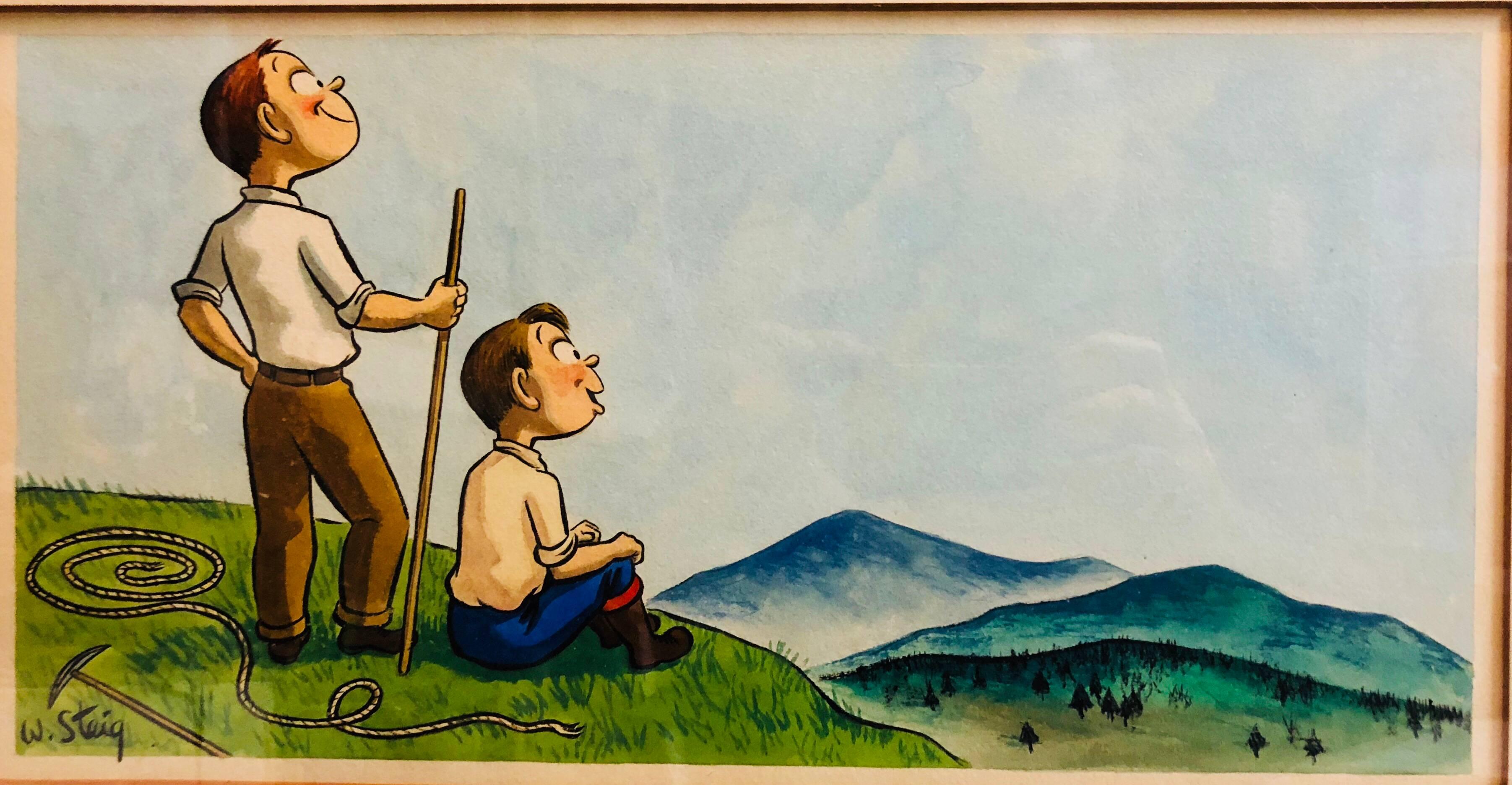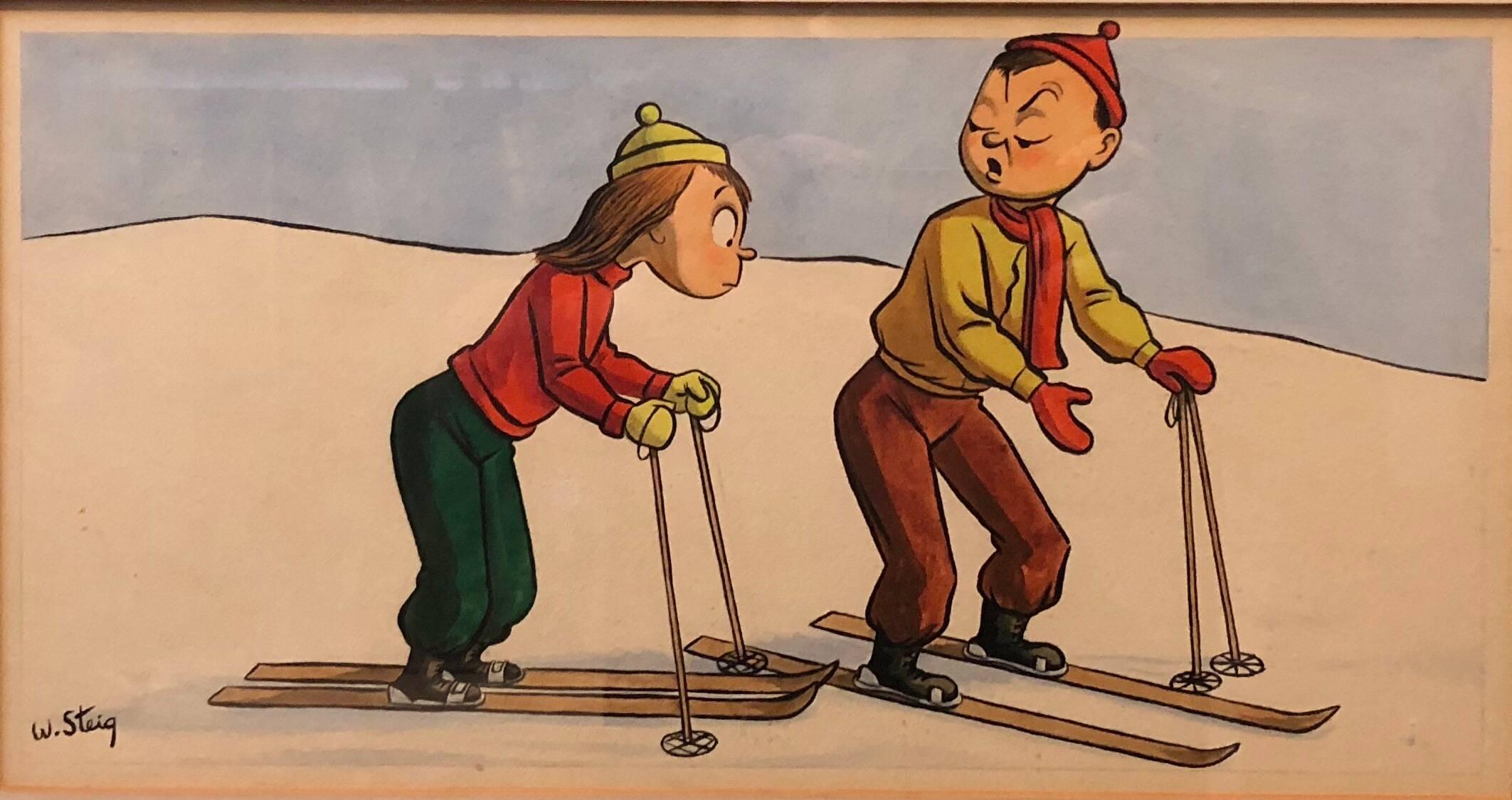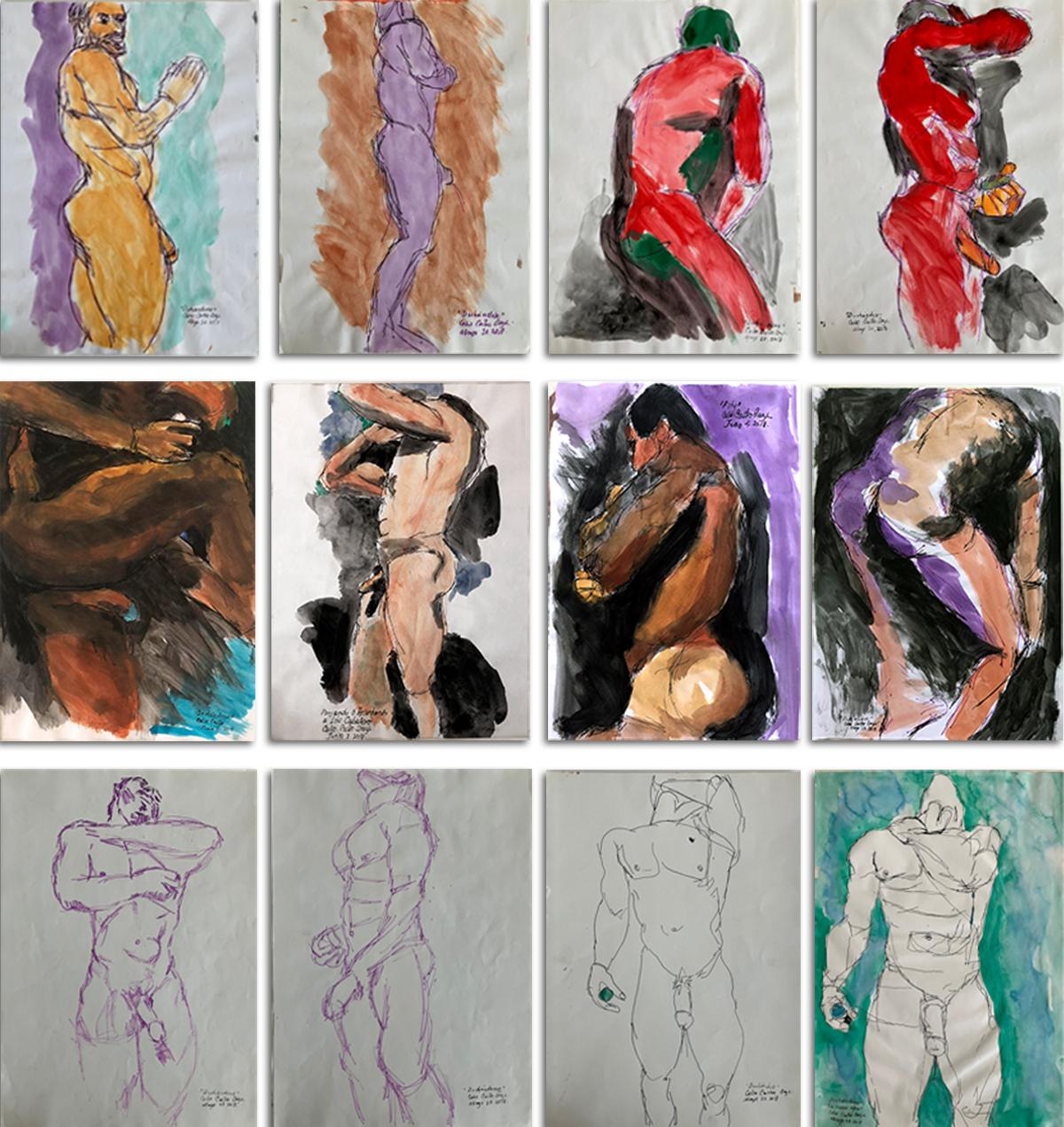Henry SommUNTITLED - ACTRESS ON STAGE
About the Item
- Creator:Henry Somm (1844-1907, French)
- Dimensions:Height: 16 in (40.64 cm)Width: 12 in (30.48 cm)Depth: 2 in (5.08 cm)
- Medium:
- Period:
- Condition:
- Gallery Location:Portland, ME
- Reference Number:
Henry Somm
François Clément Sommier, best known under the pseudonym “Henry Somm” was born in Rouen in 1844. He attended the local École municipale des beaux-arts and went on in 1867 to Paris, where he studied under Isidore Pils (1813–75). He moved to Paris in 1860. Between 1873 and 1876, he made many engravings for the magazine Paris à l'eau-forte and then at the Cadart printing house. In 1879 and 1889, he participated in the Impressionist exhibitions from the Durand-Ruel gallery in Paris. He collaborated with the newspapers like Le Chat noir, La Charge, La Cravache, La Chronique parisienne, High Life, Frou-Frou and Le Rire. He wrote the comedy in one act La Berline de l'Émigré ou Jamais trop tard pour bien faire, created for Le Chat noir on December 25, 1885. Somm left a large number of drawings and watercolors of Paris made in plein air.
- ShippingRetrieving quote...Ships From: Portland, ME
- Return PolicyA return for this item may be initiated within 10 days of delivery.
- PROPHET AND SCROLLBy Ben-ZionLocated in Portland, MEBen-Zion. PROPHET AND SCROLL. Ink on paper, undated. Titled and signed in ink lower left. 10 1/8 x 6 3/4 inches. Light foxing or dampstaining to the sheet. A strong drawing in Ben-Z...Category
Mid-20th Century Figurative Drawings and Watercolors
MaterialsInk
- COMEDIA DEL ARTE - TWO DRAWINGS.Located in Portland, MEDanovich, Francis (American, 1920-1956). COMEDIA DEL ARTE - TWO DRAWINGS. Ink on card, not dated, likely circa 1940-50. Initialed in ink within the i...Category
1940s Figurative Drawings and Watercolors
MaterialsInk
- UNTITLED (KEEP SMILING)By John HelikerLocated in Portland, MEHeliker, John. (American, 1909-2000). UNTITLED ("KEEP SMILING). Ink on paper, not dated, likely 1930s. The image is of two men in a workshop, one possibly the customer, the other wor...Category
1930s Figurative Drawings and Watercolors
MaterialsInk
- UNTITLED - WOMAN CARRYING A BAGBy Henri Gaudier-BrzeskaLocated in Portland, MEGaudier-Brzeska, Henri. UNTITILED - WOMAN CARRYING A BAG. Drawing, Ink on paper, undated. Initialed/monogrammed in pencil, lower center. This monogram is a known form which Gaudier ...Category
1910s Figurative Drawings and Watercolors
MaterialsInk
- UNTITLED (WOMAN LOOKING IN PURSE).By Isabel BishopLocated in Portland, MEBishop, Isabel. UNTITLED (WOMAN LOOKING IN PURSE). Ink on cardstock, not dated. Unsigned. 5 x 5 inches. A fast, likely unposed sketch of a passerby. In excellent condition. Isabel Bishop, 1902-1988. Isabel Bishop was born and raised in the Midwest. She came to New York in 1918 where she studied at the New York School of Applied Design for Women and the Art Students League, where her teachers included Kenneth Hayes Miller and Guy Pene du Bois. In 1934 she rented a studio in Union Square where she worked for the remainder of her career, often taking as her subjects the men and women who worked in the shops and offices on the square, or who walked or sat in Union Square Park. She was a great draughtsman, and much of her graphic work is devoted to studies of the human figure in motion or at rest within the context of their activities in Union Square or similar settings. Bishop made etchings throughout her career, producing more than 80 prints between 1925 and 1982. Prior to 1978 Bishop had editoned only a few of her prints; most of them were printed on an “as needed” basis only, by her, on her own press as gifts, or for sale. From 1978 on, Bishop collaborated with Sylvan Cole of Associated American Artists and the master printer Stephen Sholinsky...Category
Mid-20th Century Figurative Drawings and Watercolors
MaterialsInk
- ACROBATSBy Reginald MarshLocated in Portland, MEMarsh, Reginald. ACROBATS. Ink, gouache, and pastel on paper, 1922. Signed, lower right. c. 18 1/2 x 14 1/2 inches; framed to 28 x 23 1/2 x 1 1/4 inches. In excellent condition.Category
1920s Figurative Drawings and Watercolors
MaterialsInk, Pastel, Gouache
- Whimsical Illustration Hiking Cartoon, 1938 Mt Tremblant Ski Lodge William SteigBy William Steig (b.1907)Located in Surfside, FLLighthearted Illustration of Outdoor Pursuits This one being cross country hiking signed "W. Steig" Provenance: from Mrs. Joseph B. Ryan, Commissioned by Joe Ryan for the bar at his ski resort, Mount Tremblant Lodge, in 1938. Mont Tremblant, P.Q., Canada Watercolor and ink on illustration board, sights sizes 8 1/2 x 16 1/2 in., framed. In 1938 Joe Ryan, described as a millionaire from Philadelphia, bushwhacked his way to the summit of Mont Tremblant and was inspired to create a world class ski resort at the site. In 1939 he opened the Mont Tremblant Lodge, which remains part of the Pedestrian Village today. This original illustration is on Whatman Illustration board. the board measures 14 X 22 inches. label from McClees Galleries, Philadelphia, on the frame backing paper. William Steig, 1907 – 2003 was an American cartoonist, sculptor, and, in his later life, an illustrator and writer of children's books. Best known for the picture books Sylvester and the Magic Pebble, Abel's Island, and Doctor De Soto, he was also the creator of Shrek!, which inspired the film series of the same name. He was the U.S. nominee for both of the biennial, international Hans Christian Andersen Awards, as a children's book illustrator in 1982 and a writer in 1988. Steig was born in Brooklyn, New York in 1907, and grew up in the Bronx. His parents were Polish-Jewish immigrants from Austria, both socialists. His father, Joseph Steig, was a house painter, and his mother, Laura Ebel Steig, was a seamstress who encouraged his artistic leanings. As a child, he dabbled in painting and was an avid reader of literature. Among other works, he was said to have been especially fascinated by Pinocchio.He graduated from Townsend Harris High School at 15 but never completed college, though he attended three, spending two years at City College of New York, three years at the National Academy of Design and a mere five days at the Yale School of Fine Arts before dropping out of each. Hailed as the "King of Cartoons" Steig began drawing illustrations and cartoons for The New Yorker in 1930, producing more than 2,600 drawings and 117 covers for the magazine. Steig, later, when he was 61, began writing children's books. In 1968, he wrote his first children's book. He excelled here as well, and his third book, Sylvester and the Magic Pebble (1969), won the Caldecott Medal. He went on to write more than 30 children's books, including the Doctor DeSoto series, and he continued to write into his nineties. Among his other well-known works, the picture book Shrek! (1990) formed the basis for the DreamWorks Animation film Shrek (2001). After the release of Shrek 2 in 2004, Steig became the first sole-creator of an animated movie franchise that went on to generate over $1 billion from theatrical and ancillary markets after only one sequel. Along with Maurice Sendak, Saul Steinberg, Ludwig Bemelmans and Laurent de Brunhofff his is one of those rare cartoonist whose works form part of our collective cultural heritage. In 1984, Steig's film adaptation of Doctor DeSoto directed by Michael Sporn was nominated for the Academy Award for Best Animated Short Film. As one of the most admired cartoonists of all time, Steig spent seven decades drawing for the New Yorker magazine. He touched generations of readers with his tongue–in–cheek pen–and–ink drawings, which often expressed states of mind like shame, embarrassment or anger. Later in life, Steig turned to children's books, working as both a writer and illustrator. Steig's children's books were also wildly popular because of the crazy, complicated language he used—words like lunatic, palsied, sequestration, and cleave. Kids love the sound of those words even if they do not quite understand the meaning. Steig's descriptions were also clever. He once described a beached whale as "breaded with sand." Throughout the course of his career, Steig compiled his cartoons and drawings into books. Some of them were published first in the New Yorker. Others were deemed too dark to be printed there. Most of these collections centered on the cold, dark psychoanalytical truth about relationships. They featured husbands and wives fighting and parents snapping at their kids. His first adult book, Man About Town, was published in 1932, followed by About People, published in 1939, which focused on social outsiders. Sick of Each Other, published in 2000, included a drawing depicting a wife holding her husband at gunpoint, saying, "Say you adore me." According to the Los Angeles Times, fellow New Yorker artist Edward Sorel...Category
1930s Naturalistic Figurative Drawings and Watercolors
MaterialsArchival Ink, Watercolor, Illustration Board
- Whimsical Illustration Skiing Cartoon, 1938 Mt Tremblant Ski Lodge William SteigBy William Steig (b.1907)Located in Surfside, FLLighthearted Illustration of Outdoor Pursuits This one being a Skiing scene, a boy and a girl on skis. signed W. Steig Provenance: from Mrs. Joseph B. Ryan, Commissioned by Joe Ryan for the bar at his ski resort, Mount Tremblant Lodge, in 1938. Mont Tremblant, P.Q., Canada Watercolor and ink on illustration board, sights sizes 8 1/2 x 16 1/2 in., framed. In 1938 Joe Ryan, described as a millionaire from Philadelphia, bushwhacked his way to the summit of Mont Tremblant and was inspired to create a world class ski resort at the site. In 1939 he opened the Mont Tremblant Lodge, which remains part of the Pedestrian Village today. This original illustration is on Whatman Illustration board. the board measures 14 X 22 inches. label from McClees Galleries, Philadelphia, on the frame backing paper. William Steig, 1907 – 2003 was an American cartoonist, sculptor, and, in his later life, an illustrator and writer of children's books. Best known for the picture books Sylvester and the Magic Pebble, Abel's Island, and Doctor De Soto, he was also the creator of Shrek!, which inspired the film series of the same name. He was the U.S. nominee for both of the biennial, international Hans Christian Andersen Awards, as a children's book illustrator in 1982 and a writer in 1988. Steig was born in Brooklyn, New York in 1907, and grew up in the Bronx. His parents were Polish-Jewish immigrants from Austria, both socialists. His father, Joseph Steig, was a house painter, and his mother, Laura Ebel Steig, was a seamstress who encouraged his artistic leanings. As a child, he dabbled in painting and was an avid reader of literature. Among other works, he was said to have been especially fascinated by Pinocchio.He graduated from Townsend Harris High School at 15 but never completed college, though he attended three, spending two years at City College of New York, three years at the National Academy of Design and a mere five days at the Yale School of Fine Arts before dropping out of each. Hailed as the "King of Cartoons" Steig began drawing illustrations and cartoons for The New Yorker in 1930, producing more than 2,600 drawings and 117 covers for the magazine. Steig, later, when he was 61, began writing children's books. In 1968, he wrote his first children's book. He excelled here as well, and his third book, Sylvester and the Magic Pebble (1969), won the Caldecott Medal. He went on to write more than 30 children's books, including the Doctor DeSoto series, and he continued to write into his nineties. Among his other well-known works, the picture book Shrek! (1990) formed the basis for the DreamWorks Animation film Shrek (2001). After the release of Shrek 2 in 2004, Steig became the first sole-creator of an animated movie franchise that went on to generate over $1 billion from theatrical and ancillary markets after only one sequel. Along with Maurice Sendak, Saul Steinberg, Ludwig Bemelmans and Laurent de Brunhofff his is one of those rare cartoonist whose works form part of our collective cultural heritage. In 1984, Steig's film adaptation of Doctor DeSoto directed by Michael Sporn was nominated for the Academy Award for Best Animated Short Film. As one of the most admired cartoonists of all time, Steig spent seven decades drawing for the New Yorker magazine. He touched generations of readers with his tongue–in–cheek pen–and–ink drawings, which often expressed states of mind like shame, embarrassment or anger. Later in life, Steig turned to children's books, working as both a writer and illustrator. Steig's children's books were also wildly popular because of the crazy, complicated language he used—words like lunatic, palsied, sequestration, and cleave. Kids love the sound of those words even if they do not quite understand the meaning. Steig's descriptions were also clever. He once described a beached whale as "breaded with sand." Throughout the course of his career, Steig compiled his cartoons and drawings into books. Some of them were published first in the New Yorker. Others were deemed too dark to be printed there. Most of these collections centered on the cold, dark psychoanalytical truth about relationships. They featured husbands and wives fighting and parents snapping at their kids. His first adult book, Man About Town, was published in 1932, followed by About People, published in 1939, which focused on social outsiders. Sick of Each Other, published in 2000, included a drawing depicting a wife holding her husband at gunpoint, saying, "Say you adore me." According to the Los Angeles Times, fellow New Yorker artist Edward Sorel...Category
1930s Naturalistic Figurative Drawings and Watercolors
MaterialsArchival Ink, Watercolor, Illustration Board
- Mixed Media "Hangover" Vodka Bar Cart Pop Art Drawing NYC Street ArtBy Ephraim WuenschLocated in Surfside, FLThis is a reworked ad from a magazine, featuring Grey Goose, Stolichnaya, Ketel One and Belvedere Vodka with tomato juice resting on a tipsy bar cart. It is then drawn and modified b...Category
2010s Street Art Mixed Media
MaterialsOil Pastel, Archival Ink, Mixed Media, Permanent Marker
- From the Duchándome, Nudes Series. Set of 4 Watercolors on archival paperBy Celso José Castro DazaLocated in Miami Beach, FLDuchándome and Pity June 4th, by Celso Castro-Daza From the Duchándome Series Watercolor, ink, and pastel on archival paper. 1. Duchándome 2. Pensando & recordando a Luis Caballero...Category
2010s Contemporary Nude Drawings and Watercolors
MaterialsPastel, Archival Ink, Watercolor, Archival Paper
- Duchándome Nude, Series. Set of 4 Watercolors on archival paper.By Celso José Castro DazaLocated in Miami Beach, FLSet of 4 by Celso Castro-Daza From the Duchándome Series Watercolor and ink on archival paper 1. Duchándome May 22nd 2. Duchándose, May 27th 3. Duchándome May 28th 4. Duchándose, May 27th Overall Size: 39 in. H x 27.5 in. W Individual size: 19.5 in. H x 13.75 in. W Unframed 2018 Drawing on paper is his basic work tool, some are sketches of his surviving works, and others are sketches of moments he documents. ____________ Undefined by medium, Celso Castro’s works each carry the presence of the artist’s hand through the transparency of their process. Castro’s oeuvre is strongly divided between his photomontage assemblies and watercolor paintings: the prior is marked by the labor-intensive deconstruction of portrait photographs and the latter, by the seemingly frenzied recreation of a past encounter rendered in the drips and scribbles of paint and ink. Both discriminating in what they reveal of the subject, his photomontage and watercolor portraits exude raw sexuality through the combination of Castro’s mark-making and gaze. Celso Castro’s work is a bare-bulb erotic photo...Category
2010s Contemporary Nude Drawings and Watercolors
MaterialsWatercolor, Archival Ink, Archival Paper
- From the Duchándome Nude, Series. Set of 12 Watercolors & Ink on archival paperBy Celso José Castro DazaLocated in Miami Beach, FLDuchando me series by Celso José Castro - Daza 1. Duchándome May 22nd 2. Duchándose, May 27th 3. Duchándome May 28th 4. Duchándose, May 27th 5. Duchándome, June 5th 6. Pensando & recordando a Luis...Category
2010s Contemporary Nude Drawings and Watercolors
MaterialsArchival Ink, Ink, Watercolor, Archival Paper






